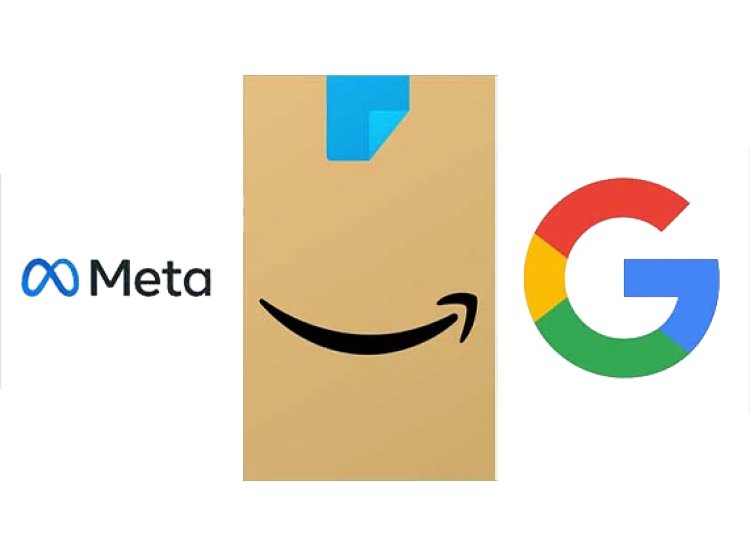Amazon Gains While Google and Meta Face Advertising Setbacks?
Amazon's Advertising Advantage in E-Commerce: Thriving on Strong Purchase Intent and Personalized Data, Experts in the Field Emphasize Its Competitive Edge

Amazon's advertising network, already valued in the billions, is positioned to become one of the company's major profit drivers. The latest financial results reveal astounding growth in Amazon's ad business, recording over $12 billion in global revenue during the third quarter. This marks an impressive 25% year-on-year increase, while major players like Google and Meta saw growth rates of approximately 10% and 15%, respectively, in the same quarter.
In 2022, Amazon raked in an astonishing $38 billion from advertising alone, solidifying its strong presence with nearly a 7% share in the digital advertising market.
Remarkably, Amazon's ad business continues to thrive, seemingly unaffected by global economic concerns, such as the Israel-Hamas conflict, and privacy changes made to Apple's operating system.
The rapid growth of online retail has led e-commerce companies to explore alternate revenue streams, extending beyond just shopping. Travel, airlines, luxury brands, and holiday providers are among the businesses eager to get a piece of the action, and those with effective advertising technology solutions are emerging as winners. In India, both Flipkart and Amazon are gaining substantial traction in this competitive landscape.
The Role of Retail Media:
Retail media has emerged as a formidable challenger to the advertising duopoly of Google and Facebook. These platforms leverage their first-party data on consumer shopping and purchasing behavior, granting them an advantage over the more general online behavioral data offered by Facebook and Google. As a result, product discovery and searches are shifting from Google to Amazon.
Amazon's personalized data and higher purchase intent provide a significant edge in the realm of retail and product discovery. With its extensive collection of personalized data, it is projected that Amazon's advertising revenues may reach a remarkable $35-40 billion by the end of the year.
The Shift to Commerce Media:
Commerce media is poised for substantial growth, especially with the impending shift to a cookieless world, making behavioral data harder to access. While search remains the primary driver of growth in retail media, the future is likely to see in-store media and shoppable video ads playing a more prominent role, according to industry experts.
India's Mirror Trends:
Experts anticipate that India's digital advertising landscape will mirror global trends. Search advertising may lose ground to e-commerce advertising, aligning with the broader trend. The forthcoming financial results from Google India and Amazon India for FY23 will provide more insights.
Amazon's Impact on India:
In India, Amazon's ad revenue for FY22 reached INR 4,170 crore, representing about 8.3% of the total online ad market, which is valued at roughly INR 50,000 crore. Amazon and Flipkart collectively contributed nearly INR 6,000 crore in ad revenue during the last fiscal year.
The Growth of Retail Media in India:
Retail media currently accounts for about 12% of total ad spending in India, and experts predict that it will double by 2024. At the agency level, approximately 20% of overall digital ad spending is directed toward online retail, with expectations that digital advertising expenditures will allocate between 25-30% to online retail by 2024.
The Influence of Retail Media:
The recent decline in ad revenue growth for Facebook India can be attributed, in part, to e-commerce advertising and retail marketing's increased share of the advertising pie. This indicates a growing significance of retail media in the digital advertising landscape.
Other Players in the Market:
Meta India reported a 13% increase in gross advertising revenue, reaching INR 18,308 crore in FY23, compared to a 74% increase in the previous year. Jio Ads is also making strides in the retail market by harnessing data from both online transactions and its extensive network of offline stores.
Key Drivers of Growth:
Amazon's retail media network has come a long way since its launch in 2012. It only began disclosing its advertising business in its filings in Q4 2021, revealing an annual revenue of $31 billion.
The growth of retail media is primarily driven by the rapid expansion of the e-commerce sector. The sector is expected to grow from $100 billion to $350 billion by 2030, according to Sachin Kumar, Founder of Bottle Openers, citing a report from RedSeer.
Siddhartha Sahni, Chief Client and Strategy Officer at 4AM Worldwide, notes that the trend initially began with grocery e-commerce but has now expanded across various categories, including education, gaming, fintech, luxury retail, and direct-to-consumer brands.
Advertiser Investments:
Ad spending on retail media can range from 5% to 100%, depending on the category and company size. Many fashion, beauty, and personal care brands, particularly small and medium-sized businesses, allocate 100% of their marketing budgets to e-commerce advertising.
Two Notable Trends:
Sahni highlights two key trends in the evolving retail media landscape. The first is a shift from on-site conversions to comprehensive campaign integration, utilizing multiple channels to reach consumers and drive results. These channels include voice search optimization, social commerce, influencer collaborations, AI, CTV, and even digitally in-store advertising.
Better Measurement and ROI:
Retail media ads are praised for their enhanced measurability, allowing advertisers to fine-tune their advertising strategies and maximize return on investment. E-commerce platforms are working on standardizing retail media measurements, collaborating to develop unified metrics.
Embracing Advanced Technologies:
Online retailers are increasingly adopting predictive technologies such as AI and machine learning to serve more personalized and curated advertisements to their audiences.
In conclusion, the retail media landscape is evolving rapidly, with Amazon taking a significant lead and redefining the dynamics of digital advertising. As e-commerce continues to flourish, it is evident that the sector holds vast potential for growth, providing new opportunities and challenges for advertisers and businesses worldwide.

 Sumit Rawat
Sumit Rawat 










